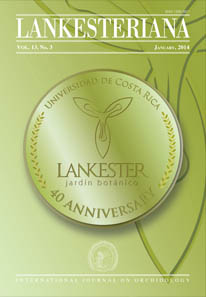Rapid transformation of orchid floras
DOI:
https://doi.org/10.15517/lank.v13i3.14349Keywords:
orchidaceae, conservation, resiliency, floristic change, forest recoveryAbstract
What does the future hold for the Orchidaceae? Historically the family has been quite plastic and responsive to large-scale habitat transformations, perhaps none so dramatic as the changes experienced during the formation of the cordilleras of the Northern Andes and lower Central America. Coupled with the backdrop of global fluctuations in climate, the rapid rise of these mountains over the last 0.5-2 M years have fragmented habitats and changed climate locally. These mountains are one of the most biologically diverse regions of the planet and may have served as a species pump for the Caribbean and other regions of Central and South America. The development of such diversity occurred over a scale of tens of millions of years to perhaps just a few thousand. While the same processes of the past are likely operational now, the current rate of habitat change may be unprecedented outside asteroid or major meteor impacts as global climate change accelerates, human- altered landscapes spread, and shifts occur in land use. We expect the structure and composition of orchid floras to change as populations respond evolutionarily through adaptation, extinctions and immigrations. Certainly the total destruction of a habitat, whether caused by volcanic eruptions or strip mining, is sure to have dire consequences but resiliency may occur if refugia serve as seed sources for colonization in the event of habitat recovery. As most orchids occupy ephemeral habitats or at least substrates, their natural population behavior likely entails cycles of local colonization and extinction as metapopulations. Another component of change is the increasing number of orchids that have become naturalized after human assisted dispersal (intentional or not). These alien orchids have overcome constraints imposed by pollination and mycorrhizal requirements. Will natural or human-assisted range expansions overcome extinction losses? Will they be among those that become the genetic material for a new wave of adaptive radiations? Much depends on population variation, patterns of gene flow, and rates of change. The Orchidaceae have had a history of ecological resiliency and evolutionary flexibility, which provides some degree of assurance. But this is no excuse for complacency since without some form of intervention the pace of change underway may be more than what orchid populations can overcome.Downloads
Download data is not yet available.
Downloads
How to Cite
Ackerman, J. D. (2014). Rapid transformation of orchid floras. Lankesteriana: International Journal on Orchidology, 13(3). https://doi.org/10.15517/lank.v13i3.14349
Issue
Section
Articles
License
According to the Open Access policy promoted by the University of Costa Rica, all the papers published by Lankesteriana are licensed under the Creative Commons copyright and can be downloaded free of charge. The journal holds copyright and publishing rights under the CC BY-NC-ND 3.0 CR license.
Before the publication of the materials submitted by the author(s) in LANKESTERIANA, the author(s) hereby assign all rights in the article to the Lankester Botanical Garden.





